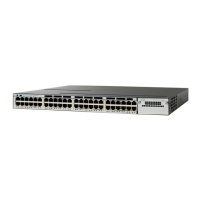2-35
Catalyst 3750 Metro Switch Command Reference
OL-9645-10
Chapter 2 Catalyst 3750 Metro Switch Cisco IOS Commands
class
class
Use the class policy-map configuration command to specify the name of the class whose traffic policy
you want to create or change. Use the no form of this command to delete an existing class from a policy
map.
class {class-map-name | class-default}
no class {class-map-name | class-default}
Syntax Description
Defaults No classes are defined.
Command Modes Policy-map configuration
Command History
Usage Guidelines Before using the class command, you must create a class map for matching packets to the class by using
the class-map global configuration command. You also must use the policy-map global configuration
command to identify the policy map and to enter policy-map configuration mode. After specifying a
policy map, you can configure a traffic policy for new classes or modify a traffic policy for any existing
classes in that policy map. The class name that you specify with the class command in the policy map
ties the characteristics for that class—that is, its policy—to the class map and its match criteria, as
configured through the class-map global configuration command. You attach the policy map to a port
by using the service-policy interface configuration command.
After you enter the class command, the switch enters policy-map class configuration mode, and these
configuration commands are available:
• bandwidth: specifies or modifies the minimum bandwidth provided to a class belonging to a policy
map. For more information, see the
bandwidth command. This command is effective only in a
hierarchical policy map attached to an enhanced-services (ES) port.
• exit: exits policy-map class configuration mode and returns to policy-map configuration mode.
• no: returns a command to its default setting.
• police: configures a single-rate policer, an aggregate policer, or a two-rate traffic policer that uses
the committed information rate (CIR) and the peak information rate (PIR) for a class of traffic. The
policer specifies the bandwidth limitations and the action to take when the limits are exceeded. For
more information, see the
police and police aggregate commands. For more information about the
two-rate policer, see the police cir and the police cir percent command. The two-rate traffic policer
commands are effective only in a hierarchical policy map attached to an ES port.
class-map-name Name of the class map.
class-default System default class that matches unclassified packets.
Release Modification
12.1(14)AX This command was introduced.
12.2(55)SE The class-default keyword was added.

